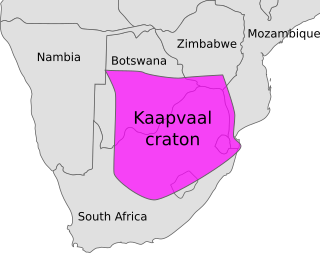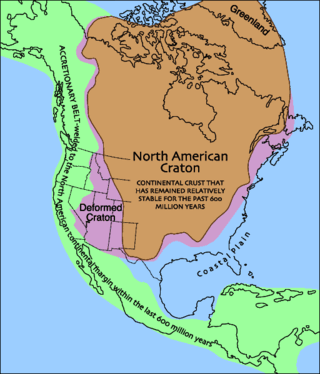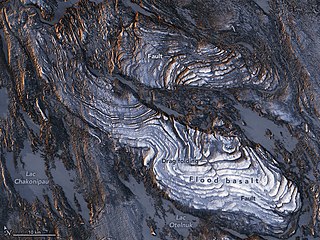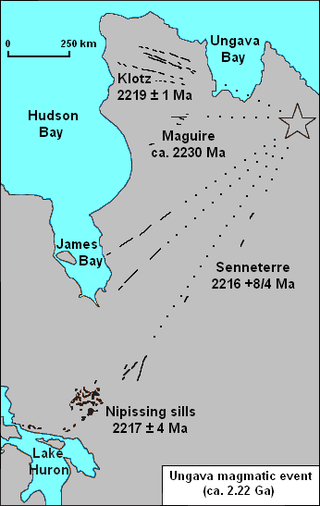
In Labrador, Canada, the North Atlantic Craton is known as the Nain Province. The Nain geologic province was intruded by the Nain Plutonic Suite, which divides the province into the northern Saglek block and the southern Hopedale block. [1]

In Labrador, Canada, the North Atlantic Craton is known as the Nain Province. The Nain geologic province was intruded by the Nain Plutonic Suite, which divides the province into the northern Saglek block and the southern Hopedale block. [1]
The North Atlantic Craton is exposed in parts of the coast of Labrador, parts of central Greenland, the Scourian Complex of northwestern Scotland and is unexposed in northern Norway. The North Atlantic Craton fragmented 2450 to 2000 million years ago. [2] : 847 When North America and Europe rejoined, the North Atlantic Craton was triangular shaped with each side 600 km (370 mi); this unit was separated when the Labrador Sea formed 61 to 40 million years ago. The crust of the North Atlantic Craton varies between 28 and 38 km (17 and 24 mi) thick [3] : 673 and its rocks are 85% granitoid gneisses. The Nain Province was intruded by the 1350- to 1290-million-year-old Nain Plutonic Suite; [3] : 673 composite anorthosite-granitic intrusions which divide the Nain Province into the northern Saglek Block and the southern Hopedale Block. [1]
In Labrador, the North Atlantic Craton is known as the Nain Province or Nain Craton. The Nain Province is more than 600 km (370 mi) long and 100 km (62 mi) wide. [1] The gneisses of the Nain Province were last deformed and metamorphosed [4] : 1245 when two blocks docked together 2500 million years ago [5] with a collisional boundary extending 200 km (120 mi) to the north and 150 km (93 mi) to the south of Nain, Labrador, Canada. [6] These two blocks appear to represent two distinct Archean cratonic nuclei, each with its own mineral depositional history. [1] Major granitic intrusions – the Wheeler Mountain, Halbach, Alliger, Sheet Hill, Loon Island, Red Island, and Satok Island intrusions – form a north-trending 150 km (93 mi) linear chain which have a southerly decrease in age – 2135-million-year-old Wheeler Mountain granite in the north to the 2025-million-year-old Satok Island monzonite in the south. [2] : 847, 848 The Nain Province was then intruded by the 1350- to 1290-million-year-old Nain Plutonic Suite; [3] : 673 composite anorthosite-granitic intrusions which divide the Nain Province into the northern Saglek block and the southern Hopedale block. [1] The Torngat orogen developed during the oblique convergence of the Superior and Nain Provinces [7] : 23, 403 900 million years ago. The crystalline crust in the Nain Province is 38 km (24 mi) thick; it thins to 9 km (5.6 mi) thick in the shelf area of the Labrador margin, where it is covered with up to 8 km (5.0 mi) of sediments. [8]
The 3800- to 3300-million-year-old Saglek block [5] is 375 km (233 mi) long and 50 km (31 mi) wide; [1] it has a north-northwesterly trend from Nain, Labrador, extending nearly to the northern tip of Labrador. This block is a high-grade gneiss terrane; it has no greenstone belts. [1] Within the gneiss are variably-sized enclaves ranging from anorthosite to ultramafic. [1] There are also three small anorthositic, ultramafic meta-igneous complexes in the gneiss near Okak Bay. [1]
The northward–trending Handy fault separates the Saglek block into two metamorphic parts. [3] : 673 The gneiss complex on the western side of the Handy fault has rocks that crystallized under granulite facies conditions; this western block is more deeply exposed than the eastern one. [3] : 681 On the eastern side amphibolite facies rocks are exposed in the northern part; they transition to granulite facies to the south. [3] : 673 The total crustal thickness is 33 km (21 mi) north of the fault and 38 km (24 mi) south of the fault. [9]

The 3100- to 2800-million-year-old Hopedale block [5] is 150 km (93 mi) long and 90 km (56 mi) wide. [1] Hopedale, Labrador, is at the eastern midpoint. This block contains the 3100-million-year-old [10] Hunt River and 3000-million-year-old Florence Lake greenstone belts, and the Weekes amphibolite which represents remnants of the older Hunt River greenstone belt. [1]

Anorthosite is a phaneritic, intrusive igneous rock characterized by its composition: mostly plagioclase feldspar (90–100%), with a minimal mafic component (0–10%). Pyroxene, ilmenite, magnetite, and olivine are the mafic minerals most commonly present.

Nunatsiavut is an autonomous area claimed by the Inuit in Newfoundland and Labrador, Canada. The settlement area includes territory in Labrador extending to the Quebec border. In 2002, the Labrador Inuit Association submitted a proposal for limited autonomy to the government of Newfoundland and Labrador. The constitution was ratified on December 1, 2005, at which time the Labrador Inuit Association ceased to exist, and the new Government of Nunatsiavut was established, initially being responsible for health, education and cultural affairs. It is also responsible for setting and conducting elections, the first of which was executed in October 2006. An election for the ordinary members of the Nunatsiavut Assembly was held on May 4, 2010. The Nunatsiavut Assembly was dissolved on April 6 in preparation for the election. Its incumbent president is Johannes Lampe who assumed office in 2016.

The Torngat Mountains are a mountain range on the Labrador Peninsula at the northern tip of Newfoundland and Labrador and eastern Quebec. They are part of the Arctic Cordillera. The mountains form a peninsula that separates Ungava Bay from the Atlantic Ocean.

Nain is the northernmost permanent settlement in the Canadian province of Newfoundland and Labrador, within the Nunatsiavut region, located about 370 km (230 mi) by air from Happy Valley-Goose Bay. The town was established as a Moravian mission in 1771 by Jens Haven and other missionaries. As of 2021, the population is 1,204 mostly Inuit and mixed Inuit-European. Nain is the administrative capital of the autonomous region of Nunatsiavut.

Hopedale is a town located in the north of Labrador, the mainland portion of the Canadian province of Newfoundland and Labrador. Hopedale is the legislative capital of the Inuit Land Claims Area Nunatsiavut, and where the Nunatsiavut Assembly meets. As of the 2021 census, it has a population of 596.

The Slave Craton is an Archaean craton in the north-western Canadian Shield, in Northwest Territories and Nunavut. The Slave Craton includes the 4.03 Ga-old Acasta Gneiss which is one of the oldest dated rocks on Earth. Covering about 300,000 km2 (120,000 sq mi), it is a relatively small but well-exposed craton dominated by ~2.73–2.63 Ga greenstones and turbidite sequences and ~2.72–2.58 Ga plutonic rocks, with large parts of the craton underlain by older gneiss and granitoid units. The Slave Craton is one of the blocks that compose the Precambrian core of North America, also known as the palaeocontinent Laurentia.

The Kaapvaal Craton, along with the Pilbara Craton of Western Australia, are the only remaining areas of pristine 3.6–2.5 Ga crust on Earth. Similarities of rock records from both these cratons, especially of the overlying late Archean sequences, suggest that they were once part of the Vaalbara supercontinent.

The Wyoming Craton is a craton in the west-central United States and western Canada – more specifically, in Montana, Wyoming, southern Alberta, southern Saskatchewan, and parts of northern Utah. Also called the Wyoming Province, it is the initial core of the continental crust of North America.

Laurentia or the North American Craton is a large continental craton that forms the ancient geological core of North America. Many times in its past, Laurentia has been a separate continent, as it is now in the form of North America, although originally it also included the cratonic areas of Greenland and also the northwestern part of Scotland, known as the Hebridean Terrane. During other times in its past, Laurentia has been part of larger continents and supercontinents and itself consists of many smaller terranes assembled on a network of Early Proterozoic orogenic belts. Small microcontinents and oceanic islands collided with and sutured onto the ever-growing Laurentia, and together formed the stable Precambrian craton seen today.

The Labrador Trough or the New Quebec Orogen is a 1,600 km (994 mi) long and 160 km (99 mi) wide geologic belt in Canada, extending south-southeast from Ungava Bay through Quebec and Labrador.

The Taltson Magmatic Zone (TMZ) is a north-trending belt of Archean to Paleoproterozoic granitic basement gneiss, amphibolite supracrustal gneissic rock and Paleoproterozoic magmatic rocks in the Canadian Shield, extending from Northern Alberta to the southwestern Northwest Territories. The TMZ basement is 3.2–3.0 Ga and the Rutledge River supracrustal gneisses 2.13–2.09 Ga years old and were intruded by magmatic rocks around 1.99–1.92 Ga.

The Algoman orogeny, known as the Kenoran orogeny in Canada, was an episode of mountain-building (orogeny) during the Late Archean Eon that involved repeated episodes of continental collisions, compressions and subductions. The Superior province and the Minnesota River Valley terrane collided about 2,700 to 2,500 million years ago. The collision folded the Earth's crust and produced enough heat and pressure to metamorphose the rock. Blocks were added to the Superior province along a 1,200 km (750 mi) boundary that stretches from present-day eastern South Dakota into the Lake Huron area. The Algoman orogeny brought the Archean Eon to a close, about 2,500 million years ago; it lasted less than 100 million years and marks a major change in the development of the Earth's crust.
The Great Lakes tectonic zone (GLTZ) is bounded by South Dakota at its tip and heads northeast to south of Duluth, Minnesota, then heads east through northern Wisconsin, Marquette, Michigan, and then trends more northeasterly to skim the northernmost shores of lakes.

The Nipissing sills, also called the Nipissing diabase, is a large 2217– to 2210–million year old group of sills in the Superior craton of the Canadian Shield in Ontario, Canada, which intrude the Huronian Supergroup. Nipissing sills intrude all the Huronian sediments and older basement rocks in the northern margin of the Sudbury Basin; they were emplaced after the faulting and folding of Huronian rocks, and are hornblende gabbro of tholeiitic basalt composition. In the Sudbury–Elliot Lake area the Nipissing diabase is deformed; outcrops are parallel to the fold axes of the Huronian sedimentary rocks. Nipissing diabase intrusions are east-northeast trending and are no wider than 460 m (1,510 ft).

The Grouse Creek block is a Precambrian basement province of 2.45 to 2.70 billion year old orthogneisses. The Grouse Creek block is one of several Proterozoic and Archean accreted terranes that lie to the north and west of the Wyoming craton, including the Farmington Canyon Complex, the Selway terrane, the Medicine Hat block and the Priest River complex. Together, these terranes comprise part of the basement rock of the North American continent and have been critical to studies of crustal accretion in the Precambrian. Ongoing study of the Grouse Creek block will contribute to understanding the paleogeography of the Wyoming craton prior to its incorporation into the supercontinent Laurentia approximately 1.86 billion years ago. The name was proposed by David Foster and others.
The geology of Quebec involves several different geologic provinces, made up of ancient Precambrian crystalline igneous and metamorphic rock, overlain by younger sedimentary rocks and soils. Most of southern Quebec is dominated by the Grenville Province, while the vast north is divided between the large Superior Province and the Churchill Province to the east, near Labrador.
The Grenville Province is a tectonically complex region, in Eastern Canada, that contains many different aged accreted terranes from various origins. It exists southeast of the Grenville Front and extends from Labrador southwestern to Lake Huron. It is bounded by the St. Lawrence River/Seaway to the southeast.
The geology of Newfoundland and Labrador includes basement rocks formed as part of the Grenville Province in the west and Labrador and the Avalonian microcontinent in the east. Extensive tectonic changes, metamorphism and volcanic activity have formed the region throughout Earth history.

The Eastern Block of the North China Craton is one of the Earth's oldest pieces of continent. It is separated from the Western Block by the Trans-North China Orogen. It is situated in northeastern China and North Korea. The Block contains rock exposures older than 2.5 billion years. It serves as an ideal place to study how the crust was formed in the past and the related tectonic settings.
The Superior Craton is a stable crustal block covering Quebec, Ontario, and southeast Manitoba in Canada, and northern Minnesota in the United States. It is the biggest craton among those formed during the Archean period. A craton is a large part of the Earth's crust that has been stable and subjected to very little geological changes over a long time. The size of Superior Craton is about 1,572,000 km2. The craton underwent a series of events from 4.3 to 2.57 Ga. These events included the growth, drifting and deformation of both oceanic and continental crusts.